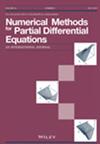电磁集中器模型的局部间断Galerkin方法的分析与应用
IF 1.7
3区 数学
Q1 MATHEMATICS, APPLIED
引用次数: 0
摘要
本文提出了一种局部不连续伽辽金(LDG)方法来模拟电磁集中器中的波传播。集中器模型由四个偏微分方程和一个常微分方程的耦合系统组成。证明了半离散和全离散LDG方案的离散稳定性和误差估计。数值结果证明了理论分析的正确性,并证明了电磁集中器具有令人感兴趣的波集中特性。本文章由计算机程序翻译,如有差异,请以英文原文为准。
Analysis and application of a local discontinuous Galerkin method for the electromagnetic concentrator model
In this paper, we develop a local discontinuous Galerkin (LDG) method to simulate the wave propagation in an electromagnetic concentrator. The concentrator model consists of a coupled system of four partial differential equations and one ordinary differential equation. Discrete stability and error estimate are proved for both semi‐discrete and full‐discrete LDG schemes. Numerical results are presented to justify the theoretical analysis and demonstrate the interesting wave concentration property by the electromagnetic concentrator.
求助全文
通过发布文献求助,成功后即可免费获取论文全文。
去求助
来源期刊
CiteScore
7.20
自引率
2.60%
发文量
81
审稿时长
9 months
期刊介绍:
An international journal that aims to cover research into the development and analysis of new methods for the numerical solution of partial differential equations, it is intended that it be readily readable by and directed to a broad spectrum of researchers into numerical methods for partial differential equations throughout science and engineering. The numerical methods and techniques themselves are emphasized rather than the specific applications. The Journal seeks to be interdisciplinary, while retaining the common thread of applied numerical analysis.

 求助内容:
求助内容: 应助结果提醒方式:
应助结果提醒方式:


